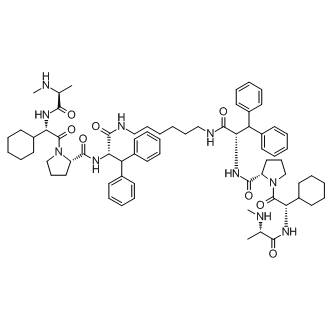All AbMole products are for research use only, cannot be used for human consumption.

BV6 induces autoubiquitination and subsequent proteasomal degradation of cIAP1 and cIAP2, and greatly sensitizes cells to TNF-induced necrosis. BV6 significantly enhances the radiosensitization of HCC193 and H460 cells in vitro. BV6 sensitizes both cell lines to radiation (HCC193-DER = 1.38, p < 0.05 at 1 μM BV6; H460-DER = 1.42, p < 0.05 at 5 μM BV6), but a higher concentration of and longer incubation time with BV6 was necessary for H460 cells.

Int J Mol Sci. 2023 Jan 24;24(3):2320.
Reovirus Type 3 Dearing Variants Do Not Induce Necroptosis in RIPK3-Expressing Human Tumor Cell Lines
BV6 purchased from AbMole

Cancer Gene Ther. 2022 Jul 22.
Gastrointestinal cancer-associated fibroblasts expressing Junctional Adhesion Molecule-A are amenable to infection by oncolytic reovirus
BV6 purchased from AbMole
| Cell Experiment | |
|---|---|
| Cell lines | HCC193 and H460 cells |
| Preparation method | Using the CellTiter 96® Aqueous Non-Radioactive Cell Proliferation Assay kit to measure cell viability . Seeding 5000 cells/well into 96-well plates in triplicate. Following adhesion of cells to the wells, adding increasing concentrations of BV6 into different wells.Exposing control groups to the same concentration of DMSO. Addng the final concentrations of 333 μg/mL MTS and 25 μM PMS to each well 24 hours later. After two hours incubation at 37 °C in humidified 5% CO2, read plates at the absorbance of 490-nm on a microplate reader.Calculating relative cell viability of an individual sample by normalizing their absorbance to that of the corresponding control. Using Prism 5.01 to calculate IC50 values . For the TNFα neutralizing antibody assay, exposing cells to 1 and 5 μM BV6 with or without 10 μg/mL infliximab and the assay is performed 24 hours later. Read plates at the absorbance of 490-nm on a microplate reader |
| Concentrations | ~30 μM |
| Incubation time | ~48 hours |
| Animal Experiment | |
|---|---|
| Animal models | |
| Formulation | |
| Dosages | |
| Administration | |
| Molecular Weight | 1205.57 |
| Formula | C70H96N10O8 |
| CAS Number | 1001600-56-1 |
| Solubility (25°C) | DMSO >51 mg/mL |
| Storage |
Powder -20°C 3 years ; 4°C 2 years In solvent -80°C 6 months ; -20°C 1 month |
| Related IAP Products |
|---|
| AZD5582 dihydrochloride
AZD5582 dihydrochloride is an antagonist of the inhibitor of apoptosis proteins (IAPs), which binds to the BIR3 domains cIAP1, cIAP2, and XIAP with IC50s of 15, 21, and 15 nM, respectively. |
| Sanggenon G
Sanggenon G is a cell-permeable and potent inhibitor of X-linked inhibitor of apoptosis protein (XIAP). |
| TD-1092
TD-1092 is a pan-inhibitor of apoptosis (IAP) degrader with two different types of E3 ligase conjugates, IAP and CRBN, that induces proteasomal degradation of cIAP2 and XIAP in a CRBN-dependent manner. TD1092 also activates apoptotic proteases (apoptosis 3/7) and leads to apoptosis by promoting IAP degradation. In addition, TD1092 also blocks the TNFα-mediated NF-κB signaling pathway and inhibits the phosphorylation of IKK, IkBα, p65, and p38. TD1092 can be used as a PROTAC for cancer research. |
| LBW242
LBW242, a 3-mer and Smac mimetic, is a potent and orally active proapoptotic IAP inhibitor. LBW242 shows effects on mutant FLT3-expressing cells. LBW242 has activity against multiple myeloma, and potentiates TRAIL- and anticancer agent-mediated cell death of ovarian cancer cells. |
| UC-112
UC-112 is a novel potent IAP(Inhibitor of apoptosis) inhibitor. UC-112 potently inhibit cell growth in two human melanoma (A375 and M14) and two human prostate (PC-3 and DU145) cancer cell lines(IC50=0.7-3.4 uM). |


Products are for research use only. Not for human use. We do not sell to patients.
© Copyright 2010-2024 AbMole BioScience. All Rights Reserved.
